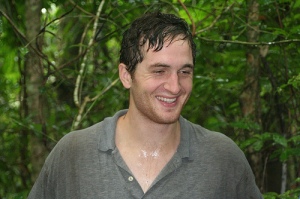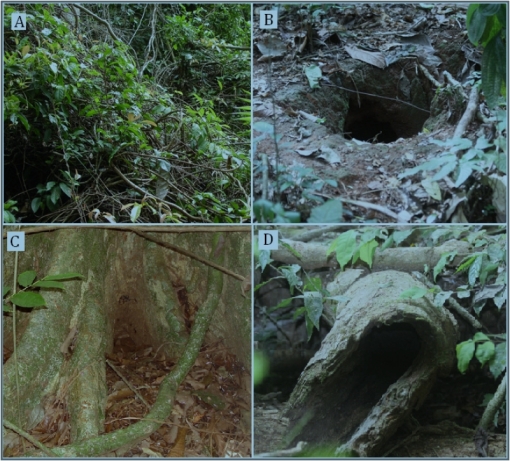On Barro Colorado Island we have the rich agoutis and the poor agoutis. The rich agoutis live in fancy neighborhoods with lots of palm trees, which make nuts for them to eat. The poor agoutis live in areas with few palm trees, the agouti ghettos, with less food. Rich or poor, all agoutis bury seeds in scattered underground caches as an insurance policy for the end of the rainy season, when there is almost no freshly produced fruit. Of course, the trees would rather the agoutis don’t come back later and eat the seeds, giving the seeds a chance to germinate and grow into a new generation of trees. These buried seeds are more likely to be dug up in the agouti ghettos, where seeds are more valuable because they are so scarce.
One of the ways that a cached seed might avoid being eaten by an agouti is if the agouti which buried the seed dies. This leads to the question: do predators like ocelots help palm trees by killing agoutis before they have a chance to go back and dig up palm seeds? Related to this, is the question: are agoutis living where food is scarce more likely to get killed because they must work harder for their food, thus take more risks?

These are the questions asked by Willem-Jan Emsens, a Masters student at Wageningen University. He studied activity patterns, refuge use, and space use of agoutis in relation to predation risk. He compared rich and poor agoutis: animals that differed strongly in the amount of Astrocaryum fruits they had in their home range. As any loyal reader of the Agouti Enterprise knows, Astrocaryum fruits are the most important food resource to agoutis.
Willem-Jan used the Automated Radio Tracking System (ARTS) to track the animals 24/7 and determine the home range size of the radio-collared agoutis. This showed that poor agoutis had larger home ranges than rich agoutis. Not surprisingly, poor agoutis seem to need a larger area to find enough food. Therefore, they may take more risks of getting caught by an ocelot.
Willem-Jan also took his radio-tracking receiver and tromped around BCI at night, when agoutis are sleeping, to find out exactly where agoutis had their refuges. He found agoutis used three types of sleeping sites: dense vegetation, burrows, and hollow logs. Each agouti had a 2-8 different places they could sleep on different nights.
Once he identified the sleeping sites, Willem-Jan put camera traps at burrow entrances to see exactly when they came and went. Agoutis never left their refuge before sunrise, but were more variable in the time they went to bed. Most agoutis retired to bed around sunset, but 13% came back at night. The cameras also caught some amazing footage of ocelots coming to these sleeping sights and looking for agoutis. You can actually see the ocelots looking into logs, presumably scaring the crap out of an agouti, but then leaving empty handed. Ocelots were the only predators that visited the refuges, and they visited refuges more often than random locations. It seems that ocelots knew where the agoutis were sleeping dropped by hoping to catch one near the entrance to their burrow.
Some of the agoutis that Willem-Jan was studying were killed by ocelots. By analyzing the ARTS data, he was able to determine the exact time the agouti was killed. Willem-Jan found that agoutis are most susceptible to predation around dusk and dawn, which is also when they overlap most in activity with the nocturnal ocelots. This may also be tied to their entrances and exits from dens. If ocelots know these locations, they might wait nearby to catch a commuting agouti.
One of the surprising results came from comparing the location of the refuges with the overall space use of agoutis. We presumed that agoutis would act like many other burrowing animals, using the refuge as a ‘central place’ and conducting feeding bouts more near the hiding hole than far from it. But this was not the case. Maybe the fear of a lurking ocelot is enough to make an agouti keep its kitchen and bedroom in different parts of its home range.
Finally, combining his work with data collected by an earlier student on the project, Lennart Suselbeek, we were able to compare the risks taken by the rich and poor agoutis. The ghetto agoutis had to be more active to find food in their enlarged home ranges, and accomplished this by getting up earlier and going to bed later. This is risky behavior when your neighborhood is patrolled by nocturnal ocelots. All of this makes the agoutis nervous, but is quite fine with the Astrocaryum trees, who root for the agoutis to burry their seeds and then the ocelot to make them disappear.










